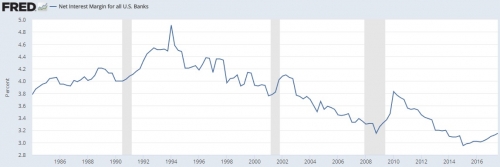The average price-to-earnings ratio of the S&P 500 is now 25, and the cyclically-adjusted price-to-earnings ratio is over 31.
But the financial sector’s average price-to-earnings ratio is less than 17.
Banks and insurers usually trade at lower valuations than the broad market, due to the amount of leverage and interest rate sensitivity they have compared to other industries. When a recession hits and consumers are unable to pay back their debts, banks are among the first companies to take a hit to their bottom line.
There’s a lot of money to be made by buying bank stocks at good valuations that are financially sound. They are typically good dividend stocks, their business is straightforward, and with high switching costs, they have built-in economic moats around their revenue streams.
This article takes a look at the health of the overall U.S. banking industry to see if they are still good investments this far into the market cycle. Click on the images for a bigger view.
1) Net Interest Margin

Source: Federal Reserve Bank of St. Louis
The core business of a bank is to borrow money at a low interest rate via checking and savings accounts and lend it at a higher rate via mortgages, auto loans, credit card accounts, and personal loans. Many of them have other forms of revenue such as payment processing, asset management or custodianship, and taking care of routine issues like medallion signature guarantees or notarization, but the difference between borrowing and lending is where the majority of banks make most of their money.
The net interest margin is the difference between the lending rate and the borrowing rate, and the above chart shows the banking industry average net interest margin.
In the 1980’s and 1990’s it was generally over 4%, but thanks to the decade of low interest rates following the 2008 global financial crisis, it has more recently been around 3%. This seems like a small difference, but if this were to go back up to 4% it would represent a 33% increase in net interest income at no additional expense, which would substantially boost the bottom line. Even going from 3% to 3.3% is a solid 10% net interest income boost.











Leave A Comment